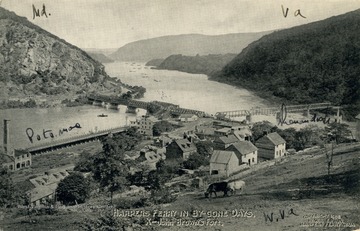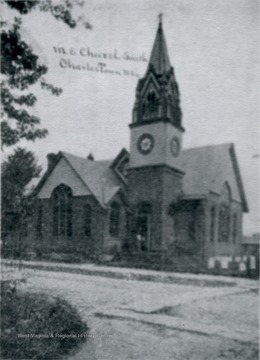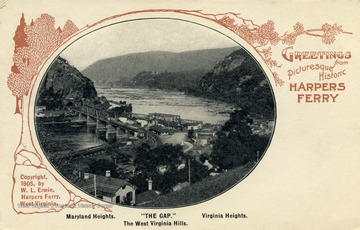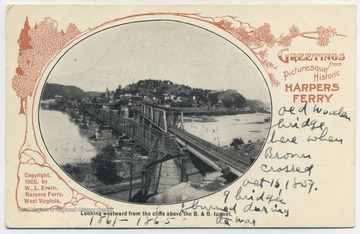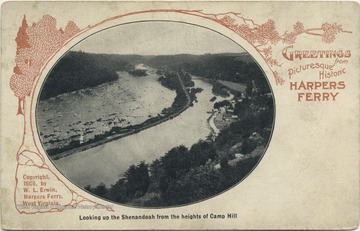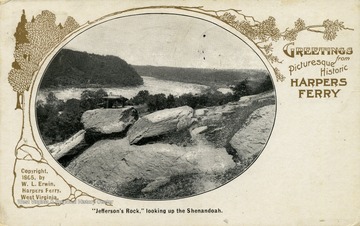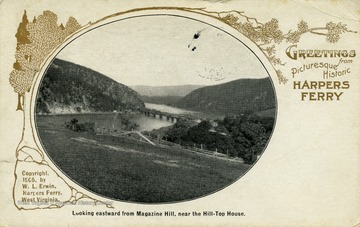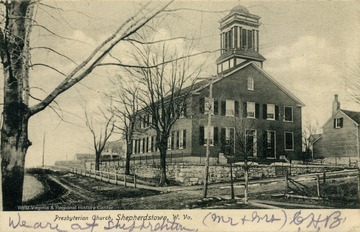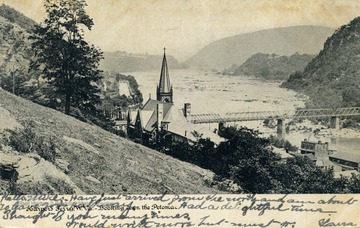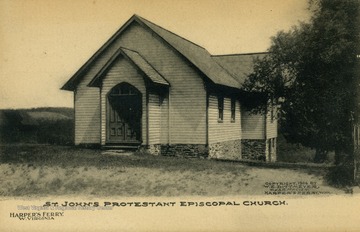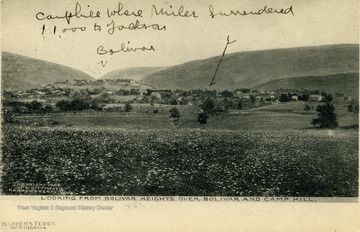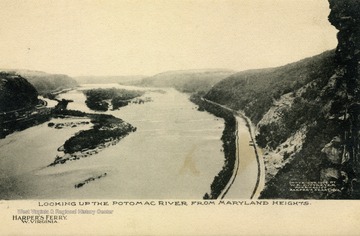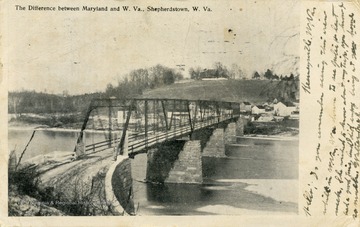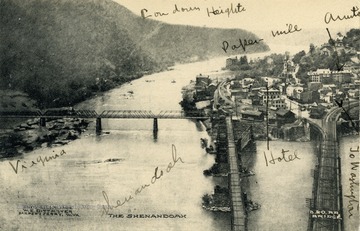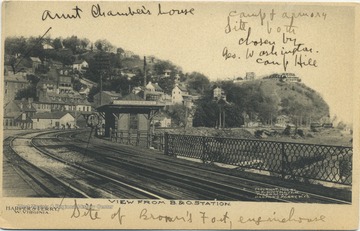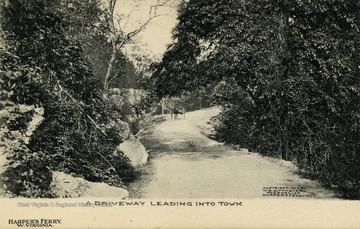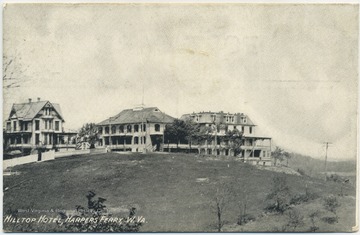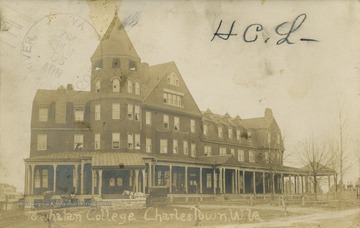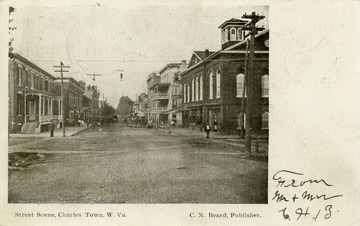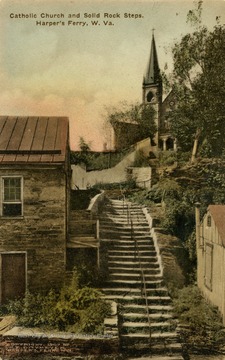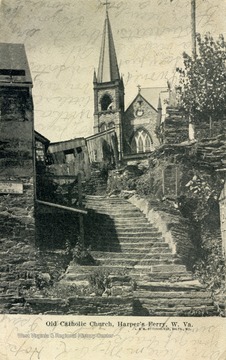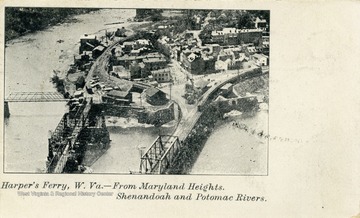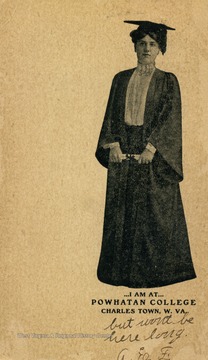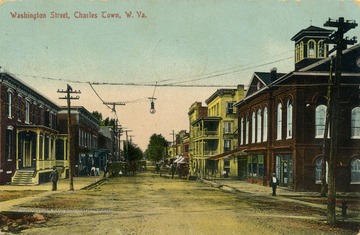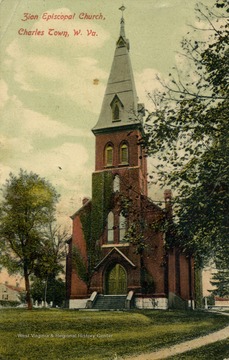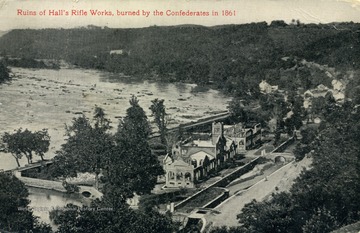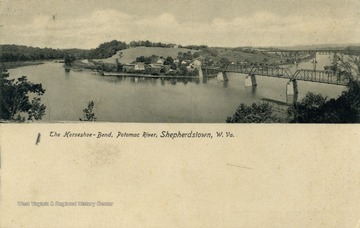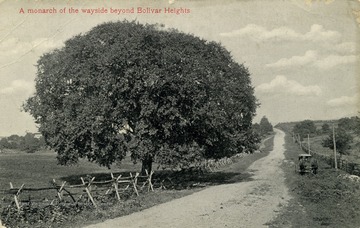Search Constraints
« Previous |
1 - 96 of 304
|
Next »
Search Results
IDNO:
046793
Title:
Illustrated Scene of People Celebrating James Rumsey's Successful Trial of the First Steamboat in the World, Shepherdstown, W. Va.
Date:
1787/12/03
Description:
James Rumsey was the inventor of the first steamboat.
IDNO:
030092
Title:
Engraving of John Storer of Sanford, Maine
Date:
1860~
Description:
Soon after the Civil War, John Storer contributed $10,000 towards establishing a college in Harpers Ferry, W. Va. This institution of higher learning was the first college below the Mason- Dixon Line to accept students "without distinction of race or color". The school bears the name of it's principle benefactor, Storer College.
IDNO:
013072
Title:
Charles Town Academy, Jefferson County, W. Va.
Date:
1877
Description:
'From an article in the Morgantown Post published in August 6, 1938. Charles Town Academy, one of the first W. Va. academies, was founded in 1979. Three sons of James Madison, 4th President of the United States, were educated here. This photograph was taken in 1877.'
IDNO:
013056
Title:
Charles Town Academy, Jefferson County, W. Va.
Date:
1877
Description:
View of the Charles Town Academy, one of the first West Virginia academies, founded in 1797. Three sons of James Madison, fourth president of the United States, were educated here.
IDNO:
048250
Title:
J.H. Smith Residence, Martinsburg, W. Va.
Date:
1901/10/10
IDNO:
029196
Title:
View from Loudoun Heights of Harpers Ferry and Bolivar Heights, W. Va.
Date:
1901/11
IDNO:
037795
Title:
Old Fairfax 'Gig', Jefferson County, W. Va.
Date:
1902
Description:
A horse harnessed to a "gig" owned by Ferdinand Fairfax, nephew of Lord Thomas Fairfax. Ferdinand lived at Shannon Hill on the Shenandoah River in Jefferson County, Virginia, later West Virginia.
IDNO:
044462
Title:
Scene of the Capture of John Brown in Harpers Ferry, W. Va.
Date:
1905
Description:
(From postcard collection legacy system--subject.)
IDNO:
045683
Title:
Niagara Movement Leaders at Storer College, Harpers Ferry, W. Va.
Date:
1906-08-15
Description:
Seated is W.E.B. Du Bois. Standing, from left to right, is J. R. Clifford, L. M. Hershaw, and F. H. M. Murray.
IDNO:
050482
Title:
Women of Niagara Movement, Harpers Ferry, W. Va.
Date:
1907
Description:
Women of the Niagara Movement at Storer College in Harpers Ferry, W. Va. Left to right are Mrs. O. M. Waller, Mrs. H. F. M. Murray, Mrs. Mollie Lewis Kelan, Mrs. IdaD. Bailey, Miss Sadie Shorter, and Mrs. Charlotte Hershaw. Mrs. Gertrude Wright Morgan is seated.
IDNO:
044468
Title:
Street Scene in Charlestown, During Trial of John Brown, Showing Jail and Court House
Date:
1908
Description:
Published by W. L. Erwin. (From postcard collection legacy system--subject.)
IDNO:
044469
Title:
Capture of John Brown by U. S. Marines at Harpers Ferry, October 18, 1859
Date:
1908
Description:
Published by W. L. Erwin. (From postcard collection legacy system--subject.)
IDNO:
044461
Title:
John Brown's Fort, Harpers Ferry, W. Va.
Date:
1909
Description:
Copyright by National Tribune. See original for postcard historical information on John Brown's fort. (From postcard collection legacy system--subject.)
IDNO:
044464
Title:
Harpers Ferry, W. Va.
Date:
1909
Description:
Copyright by National Tribune. See postcard for historical information on Harpers Ferry. (From postcard collection legacy system--subject.)
IDNO:
048220
Title:
Bolivar Heights and Camp Hill at Harper's Ferry, W. Va.
Date:
1909
IDNO:
048206
Title:
Large Ivy Covered Farm House Near Harper's Ferry, W. Va.
Date:
1909
IDNO:
029197
Title:
Looking Down the Potomac at Harper's Ferry, W. Va.
Date:
1909/03/13
Description:
Showing Three States, W. Va., Va., and Md.
IDNO:
042643
Title:
At the Old 'Bar Spring', Camp Hill, Harpers Ferry, W. Va.
Date:
1911
Description:
See original for correspondence. (From postcard collection legacy system.)
IDNO:
037791
Title:
Horse Show, Charles Town, W. Va
Date:
1913
IDNO:
037958
Title:
First Charles Town Horse Show, Jefferson County, W. Va.
Date:
1913/08/07
Description:
Horse drawn buggies crowd around the show grounds and people fill the grandstand for the competitions
IDNO:
013046
Title:
Rouse Apple Cold Storage Building, Jefferson County, W. Va.
Date:
1918/09/06
IDNO:
013047
Title:
Rouse House, Kabletown, Jefferson County, W. Va.
Date:
1918/09/06
IDNO:
048249
Title:
Rouse House, Kabletown, W. Va.
Date:
1918/09/06
IDNO:
037829
Title:
School Children in American Legion Parade, Charles Town, W. Va.
Date:
1921
IDNO:
002931
Title:
United Mine Workers Leaders and Lawyers at Jefferson County Courthouse, Charles Town, W. Va.
Date:
1922
Description:
Group portrait of United Mine Workers leaders and lawyers at Jefferson County Courthouse, W. Va. Front Row, Left to Right; James M. Mason, C. J. Van Fleet, Samuel B. Montgomery, Harold Wilkins Houston, William Blizzard, John L. Lewis, Charles Franklin Keeney.
IDNO:
037886
Title:
Ruins of St. George Chapel on Middle Way Pike Near Charles Town, W. Va.
Date:
1931/12
Description:
George Packette is the man standing near the ruins.
IDNO:
041082
Title:
Newton Vickers Home, Jefferson Co., W. Va.
Date:
1934
Description:
View from the south west.
IDNO:
041091
Title:
Effie McIntyre Home, Kearneysville, W. Va.
Date:
1936
Description:
View from the southwest.
IDNO:
041093
Title:
Level Green Slave Quarters Outbuilding, Jefferson Co., W. Va.
Date:
1936
IDNO:
041094
Title:
Traveler's Rest Slave Quarters, Jefferson Co., W. Va.
Date:
1936
Description:
View of outbuilding from south-east.
IDNO:
041095
Title:
Nathan Haines House, Summit Point, W. Va.
Date:
1936
Description:
Also known as the Fairfax Grant Stock Farm, built ca. 1775.
IDNO:
041096
Title:
Meathouse, Jefferson Co., W. Va.
Date:
1936
Description:
Outbuilding which is probably a meat house on a large farm, viewed from the south-west.
IDNO:
041100
Title:
Traveler's Rest, Jefferson Co., W. Va.
Date:
1936
Description:
View of the Horatio Gates home from the north-east.
IDNO:
041101
Title:
Osborn House, Shenandoah Junction, Jefferson Co., W. Va.
Date:
1936
IDNO:
041104
Title:
Jacob Morgan Steptoe House, Shepherdstown, W. Va.
Date:
1936
Description:
Named Falling Spring and located near Shepherdstown, West Virginia. The structure was built by Jacob Morgan in 1841. Viewed from the south-east.
IDNO:
041105
Title:
Harewood Near Charles Town, W. Va.
Date:
1936
Description:
Built by Samuel Washington, younger brother of George Washington in 1770. Viewed from the north-west.
IDNO:
041107
Title:
Cedar Lawn, Jefferson Co., W. Va.
Date:
1936
Description:
Built by John Thornton Augustine Washington, grand-nephew of George Washington, in 1825. View from the south-east.
IDNO:
041106
Title:
Harewood Near Charles Town, W. Va.
Date:
1936
Description:
Built by Samuel Washington, younger brother of George Washington, in 1770. View from the south-east.
IDNO:
041108
Title:
Woodbury, Jefferson Co., W. Va.
Date:
1936
Description:
Located near Leetown and built in 1835 by Federal Judge Henry St. George Tucker. View from the south-east.
IDNO:
041111
Title:
Peter Burr House Near Bardane, Jefferson Co., W. Va.
Date:
1936
Description:
Handhewn clapboard house was built ca. 1751. Peter Burr was first cousin to United States Vice President Aaron Burr.
IDNO:
041110
Title:
Peter Burr House Near Bardane, Jefferson Co., W. Va.
Date:
1936
Description:
Handhewn clapboard house was built ca. 1751. Peter Burr was first cousin to United States Vice President Aaron Burr.
IDNO:
041112
Title:
Piedmont Near Charles Town, Jefferson Co., W. Va.
Date:
1936
Description:
John Worthington built the original structure in 1735. Dr. John Briscoe remodeled the house to it's present day appearance in 1780. View from the south-west.
IDNO:
041115
Title:
Rosebrake, Dandridge House, Jefferson Co., W. Va.
Date:
1936
Description:
The "back House' shown in the is photograph was built in ca. 1737 by Richard Morgan, and grandson, Daniel Morgan built the "Great House" ca. 1800.
IDNO:
041120
Title:
Elmwood Slave Quarters, Jefferson Co., W. Va.
Date:
1936
Description:
Slave quarters and outbuilding viewed from the South East. Also known as the R. Lucas House.
IDNO:
041225
Title:
Vestal House Out Building, Near Charles Town, W. Va.
Date:
1936
Description:
Possibly part of the Vestal or Shenandoah Bloomery, the first ironworks west of the Blue Ridge Mountains. William Vestal operate the ironworks built on his land, from 1742 to 1760.
IDNO:
041102
Title:
Grantham House, Middleway, Jefferson Co., W. Va.
Date:
1937
Description:
Also called Tudor Hall. Built ca. 1820, the view is from the north-east.
IDNO:
041114
Title:
Ranson House, Ranson, Jefferson Co., W. Va.
Date:
1937
Description:
House was built in ca. 1845. Since the photograph was taken the house has been demolished.
IDNO:
035084
Title:
Old Selby Tavern, Shepherdstown, W. Va.
Date:
1941/02/05
Description:
The Selby-Hamtramck House, the "most fashionable hotel in town."
IDNO:
035086
Title:
Selby-Hamtramck Tavern, Shepherdstown, W. Va.
Date:
1941/02/05
IDNO:
035085
Title:
Selby-Hamtramck Tavern, Shepherdstown, W. Va.
Date:
1941/02/05
IDNO:
035083
Title:
Harris Tavern, Halltown, W. Va.
Date:
1941/02/26
Description:
"Built in 1795 by David Harris, after whom Harrisburg, Pa. was named. It is part of a very long old frame building, a part of which still stands."
IDNO:
035087
Title:
White House Tavern, Summit Point, W. Va.
Date:
1941/02/26
Description:
This tavern was "built in 1742 by the McCormick brothers."
IDNO:
013044
Title:
Church and Graveyard, Middleway, Jefferson County, W. Va.
Date:
1955/03/20
Description:
View of a church and graveyard at Middleway. It was formerly Smithfield, West Virginia.
IDNO:
037901
Title:
'Crazy House', Harpers Ferry, W. Va.
Date:
Undated
Description:
The "Crazy House" was built by a former mayor of Harpers Ferry in 1914. His hobby was collecting "old relics", which he placed inside walls of the house during construction. Such items as old china plates and bullets can be seen encased in the structure. The builder also made an impression of a coffin in the front sidewalk and wrote above it, "Remains of Old Worry", making the property an popular tourist attraction. Refer to A&M 454, Box 25; Folder 11 for more information.
IDNO:
037908
Title:
John Harris Holding 'Dan' in Charles Town, W. Va.
Date:
Undated
Description:
African-American man holding a horse in front of the Gibson - Packette house on Samuel Street.
IDNO:
037906
Title:
William B. Packette Sr.,of Charles Town, W. Va. With Little Girl and 'Prince'
Date:
Undated
Description:
William B. Packette Sr.and possibly his daughter Frances Packette in a buggy harnessed to a horse named "Prince".
IDNO:
037910
Title:
William B. Packette and Frances D. Packette of Charles Town, W. Va. and Team of 'Bird and Dan'
Date:
Undated
Description:
Father, William B. Packette and daughter, Frances Packette riding in a buggy drawn by two horses, Bird and Dan.
IDNO:
042626
Title:
Looking Down Street 'on a Busy Day', Shepherdstown, W. Va.
Date:
Undated
Description:
Dirt-paved main street looks desserted on this "busy day".(From postcard collection legacy system.)
IDNO:
046781
Title:
Collodion Glass Plate Negative of Illustration of Residence of James Rumsey, Inventor of Steamboat, Shepherdstown, Jefferson County, W. Va.
Date:
Undated
Description:
From a drawing made by Henry Howe in 1843.
IDNO:
048196
Title:
Rippon School Exhibit, Presented by Hon. H.G. Brown, Rippon, Jefferson Co., W. Va.
Date:
Undated
Description:
Various homegrown and homemade goods are present on the display tables.
IDNO:
047537
Title:
Library at Shepherd State Teacher's College, Shepherdstown, W. Va.
Date:
Undated
IDNO:
041513
Title:
Harpers Ferry; Jefferson Co., W. Va.
Date:
ca. 1860
IDNO:
042480
Title:
Union Soldiers Stand On Hillside, Harpers Ferry, Va.
Date:
ca. 1861
Description:
The photograph was most likely taken during the first year of Civil War when the Federal Army occupied Harpers Ferry, Va. (later West Virginia).
IDNO:
006601
Title:
John Brown's Fort on Murphy's Farm, Bolivar Heights, W. Va.
Date:
ca. 1900
Description:
Fort building stands in a field where two children are playing in the foreground. Inscription with the image, 'The present site of John Brown's Fort as it now stands in a field overlooking the Shenandoah River, in [West] Virginia, a few miles from where it originally stood at Harper's Ferry. It was placed here at the request of Kate Field, of Washington after it was exhibited at the World's Fair in Chicago.'
IDNO:
042634
Title:
Harper's Ferry in By Gone Days, Harpers Ferry, W. Va.
Date:
ca. 1900
Description:
Small white X in the middle of postcard on building is John Brown's Fort. All three states, Virginia, Maryland, and West Virginia can be seen as well as the confluence of the Potomac and Shenandoah Rivers. Published by W.L. Erwin. (From postcard collection legacy system.)
IDNO:
013054
Title:
Methodist Episcopal Church, South Charles Town, Jefferson County, W. Va.
Date:
ca. 1900-1909
IDNO:
042636
Title:
The Gap at Harpers Ferry, W. Va.
Date:
ca. 1905
Description:
View from the Camp Hill area in Harpers Ferry includes the confluence of the Potomac and Shenandoah Rivers, Maryland Heights and "Virginia Heights" (Loudoun Heights). (From postcard collection legacy system.)
IDNO:
042641
Title:
Harpers Ferry Looking Westward; Harpers Ferry, W. Va.
Date:
ca. 1905
Description:
View from Maryland Heights above the Baltimore and Ohio Railroad tunnel. See original for correspondence. (From postcard collection legacy system.)
IDNO:
042648
Title:
Looking Up the Shenandoah From the Heights of Camp Hill; Jefferson Co., W. Va.
Date:
ca. 1905
Description:
See original for correspondence. (From postcard collection legacy system.)
IDNO:
042655
Title:
Jefferson's Rock, Looking Up the Shenandoah; Harpers Ferry, W. Va.
Date:
ca. 1905
Description:
See original for correspondence. (From postcard collection legacy system.)
IDNO:
042671
Title:
Looking Eastward From Magazine Hill, Near the Hill Top House; Harpers Ferry, W. Va.
Date:
ca. 1905
Description:
See original for correspondence. (From postcard collection legacy system.)
IDNO:
029199
Title:
Prehistoric Mound as it appeared in 1857, Moundsville, W. Va.
Date:
ca. 1905-1925
IDNO:
042560
Title:
Presbyterian Church; Shepherdstown, W. Va.
Date:
ca. 1906
Description:
Published by Reinhart's Pharmacy. (From postcard collection legacy system.)
IDNO:
042572
Title:
Looking Over the Potomac; Harper's Ferry, W. Va.
Date:
ca. 1906
Description:
See original for correspondence. Published by The World Post Card Company. (From postcard collection legacy system.)
IDNO:
042571
Title:
St. John's Protestant Episcopal Church; Harper's Ferry, W. Va.
Date:
ca. 1906
Description:
(From postcard collection legacy system.)
IDNO:
042605
Title:
Looking From Bolivar Heights Over Bolivar and Camp Hill; Harpers Ferry, W. Va.
Date:
ca. 1906
Description:
(From postcard collection legacy system.)
IDNO:
042607
Title:
Looking Up the Potomac River From Maryland Heights; Harper's Ferry, W. Va.
Date:
ca. 1906
Description:
(From postcard collection legacy system.)
IDNO:
042627
Title:
Difference Between Maryland and W. Va.; Shepherdstown, W. Va.
Date:
ca. 1906
Description:
Bridge connecting the two states over the Potomac River. See the original for the correspondence.(From postcard collection legacy system.)
IDNO:
042632
Title:
Harpers Ferry From Maryland Heights; Harpers Ferry, W. Va.
Date:
ca. 1906
Description:
From this view you can see such things as the Shenandoah River, Loudoun Heights, Virginia, a Baltimore and Ohio Railroad Bridge, as well as a paper mill and hotel in the town of Harpers Ferry.(From postcard collection legacy system.)
IDNO:
042642
Title:
View from B & O Station; Harpers Ferry, W. Va.
Date:
ca. 1906
Description:
Several landmarks and structures, such as camp hill, the Armory and John Brown's Fort are labeled. See original for correspondence. (From postcard collection legacy system.)
IDNO:
042658
Title:
A Driveway Leading Into Town; Harpers Ferry, W. Va.
Date:
ca. 1906
Description:
(From postcard collection legacy system.)
IDNO:
042532
Title:
Hilltop Hotel; Harpers Ferry, W. Va.
Date:
ca. 1907
Description:
Published by I. & M. Ottenheimer. See original for correspondence. (From postcard collection legacy system.)
IDNO:
042588
Title:
Powhatan College; Charles Town, W. Va.
Date:
ca. 1907
Description:
See original for correspondence. (From postcard collection legacy system.)
IDNO:
042544
Title:
Street Scene; Charles Town, W. Va.
Date:
ca. 1907
Description:
Published by C.N. Beard. (From postcard collection legacy system.)
IDNO:
042580
Title:
Catholic Church and Solid Rock Steps; Harper's Ferry, W. Va.
Date:
ca. 1907
Description:
Published by W.E. Dittmeyer. (From postcard collection legacy system.)
IDNO:
042581
Title:
Old Catholic Church; Harper's Ferry, W. Va.
Date:
ca. 1907
Description:
See original for correspondence. Published by M. Ottenheimer. (From postcard collection legacy system.)
IDNO:
042624
Title:
View From Maryland Heights of Shenandoah and Potomac Rivers; Harpers Ferry, W. Va.
Date:
ca. 1907
Description:
(From postcard collection legacy system.)
IDNO:
042663
Title:
Looking Down the Potomac; Shepherdstown, W. Va.
Date:
ca. 1907
Description:
See original for correspondence. Published by Reinhart's Pharmacy. (From postcard collection legacy system.)
IDNO:
042683
Title:
Up Quarrier From Capitol Street; Charleston, W. Va.
Date:
ca. 1907
Description:
See original for correspondence. Published by Lyons Studio. (From postcard collection legacy system.)
IDNO:
042543
Title:
Student in Cap and Gown, Powhatan College; Charles Town, W. Va.
Date:
ca. 1908
Description:
(From postcard collection legacy system.)
IDNO:
042552
Title:
Washington Street; Charles Town, W. Va.
Date:
ca. 1908
Description:
See original for correspondence. Published by C.N. Beard. (From postcard collection legacy system).
IDNO:
042586
Title:
Zion Episcopal Church; Charles Town, W. Va.
Date:
ca. 1908
Description:
See original for correspondence. Published by Hayward. (From postcard collection legacy system.)
IDNO:
042598
Title:
John Brown's Fort; Harpers Ferry, W. Va.
Date:
ca. 1908
Description:
See original for correspondence. Published by W.E. Dittmeyer. (From postcard collection legacy system.)
IDNO:
042606
Title:
Ruins of Hall's Rifle Works; Harper's Ferry, W. Va.
Date:
ca. 1908
Description:
Burned by the Confederates in 1861. See original for correspondence. Published by W.L. Erwin. (From postcard collection legacy system.)
IDNO:
042623
Title:
Horseshoe Bend, Potomac River; Shepherdstown, W. Va.
Date:
ca. 1908
Description:
View of Douglas Hill, also known as Ferry Place Hill, on the Maryland side. Published by Reinhart's Pharmacy. (From postcard collection legacy system.)
IDNO:
042674
Title:
A Monarch of the Wayside Beyond Bolivar Heights; Harpers Ferry, W. Va.
Date:
ca. 1908
Description:
Published by W.L. Erwin. (From postcard collection legacy system.)
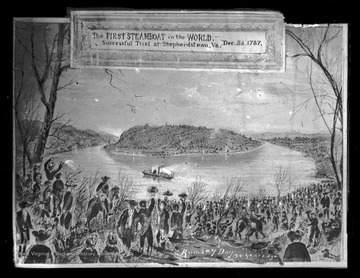
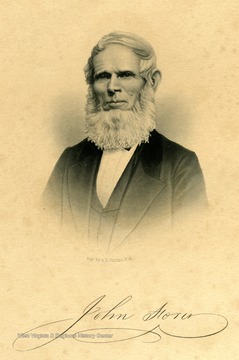
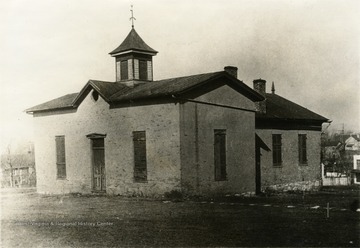



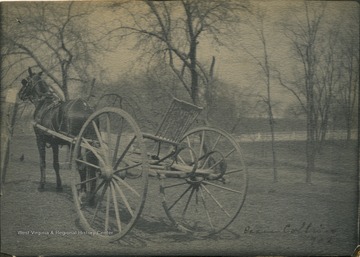
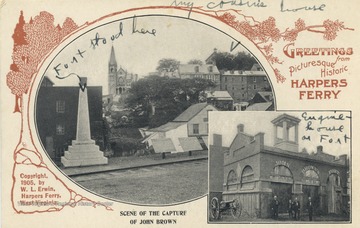
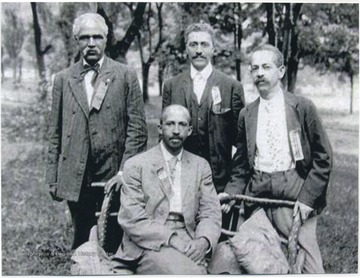
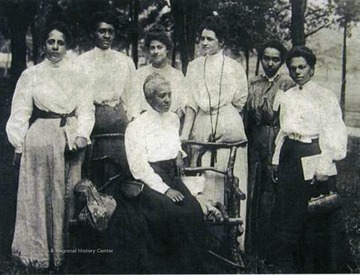
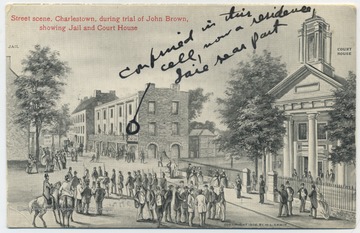
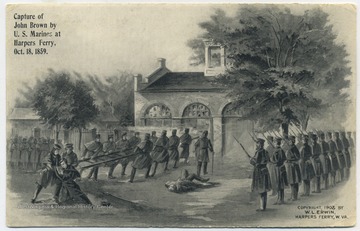
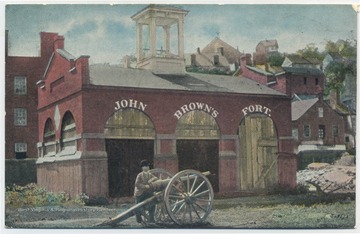
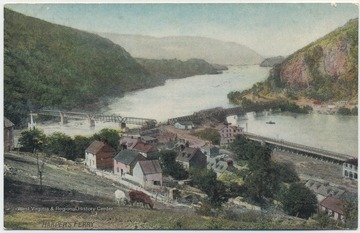


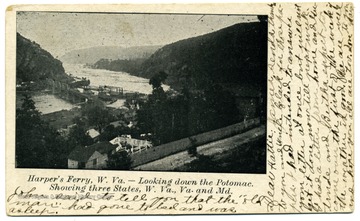
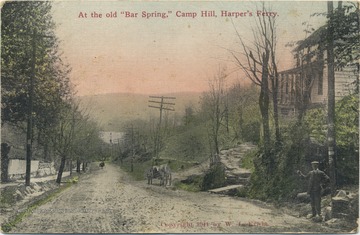

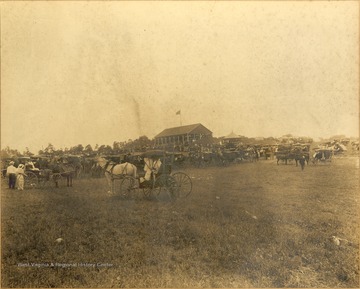





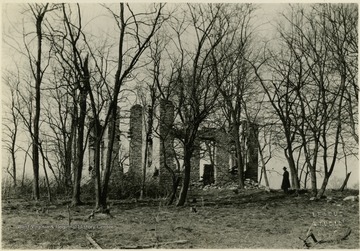
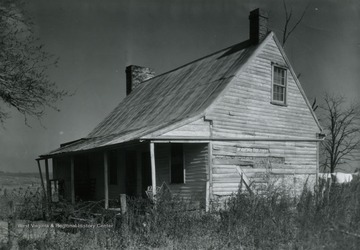

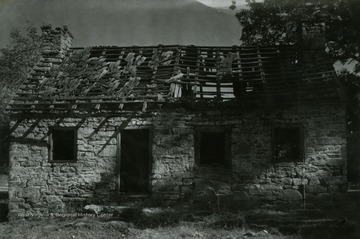
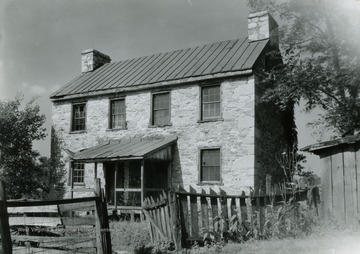
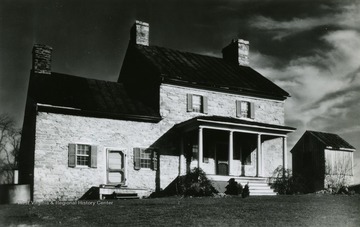

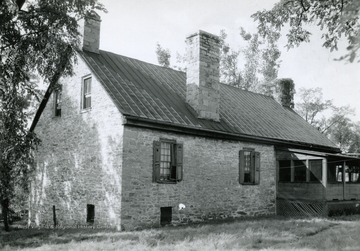
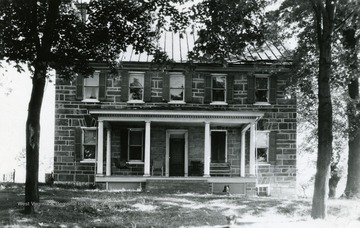
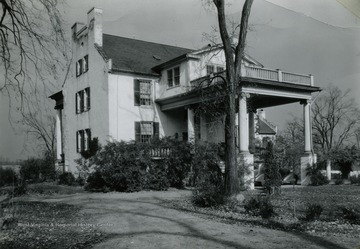
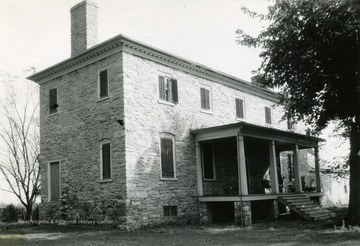
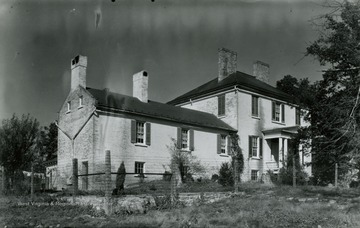
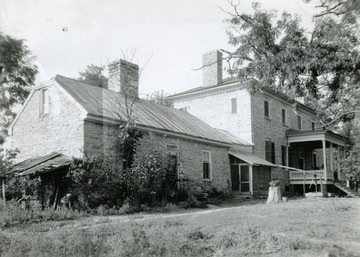
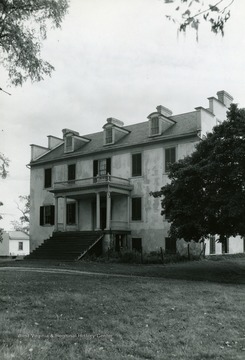
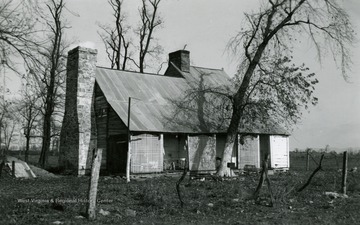
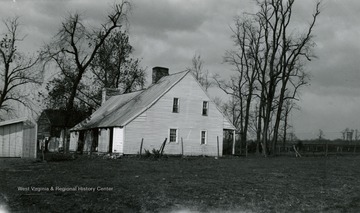
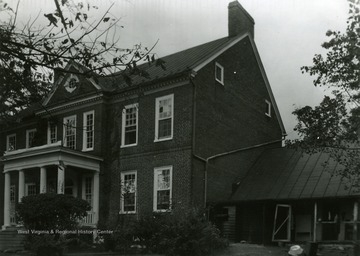
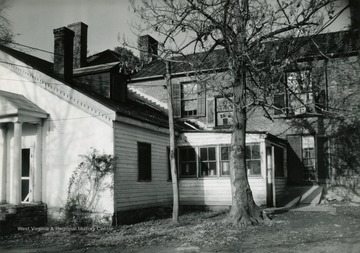
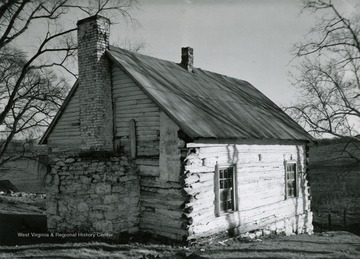
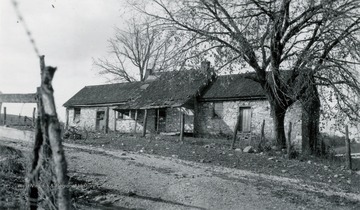
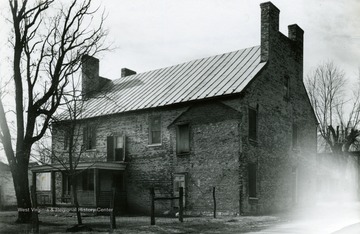
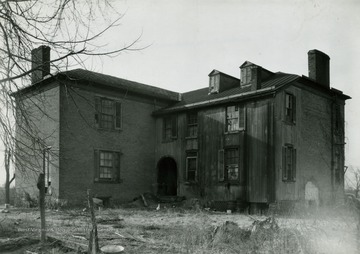
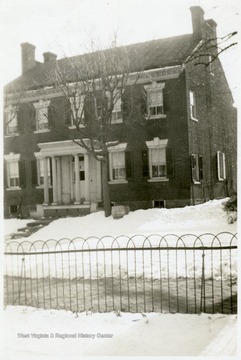
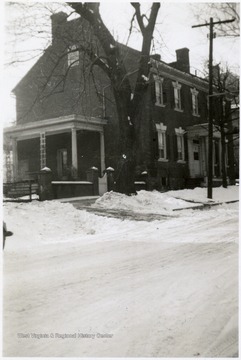
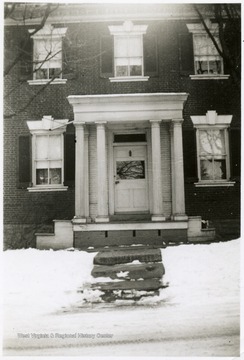
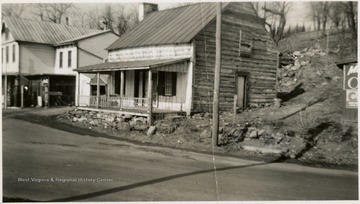
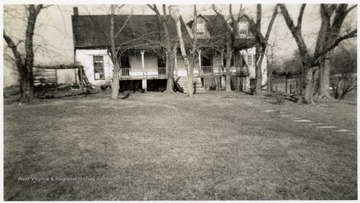
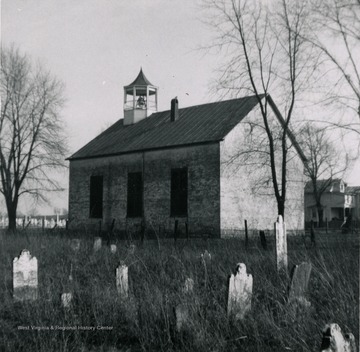
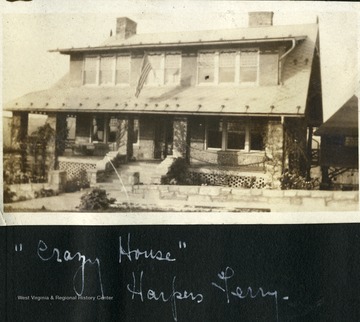
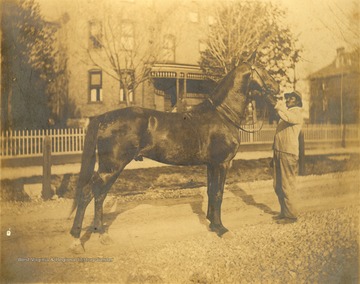
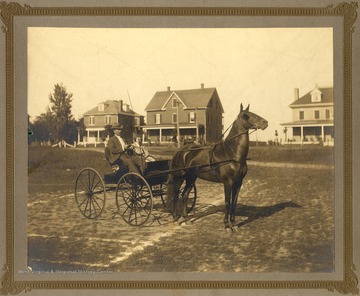
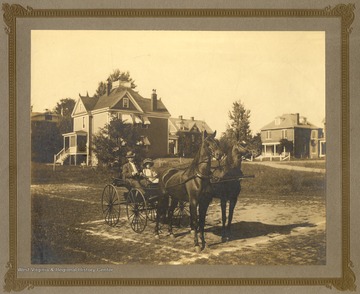
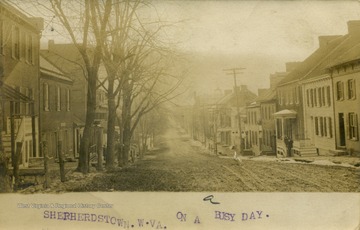

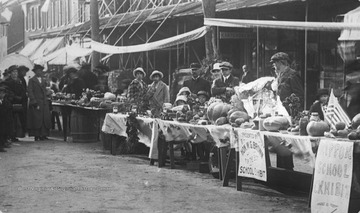


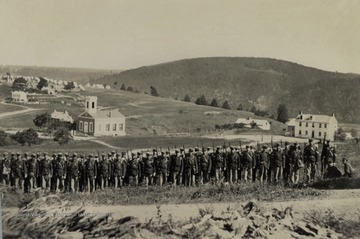
![John Brown's Fort on Murphy's Farm, Bolivar Heights, W. Va. Fort building stands in a field where two children are playing in the foreground. Inscription with the image, 'The present site of John Brown's Fort as it now stands in a field overlooking the Shenandoah River, in [West] Virginia, a few miles from where it originally stood at Harper's Ferry. It was placed here at the request of Kate Field, of Washington after it was exhibited at the World's Fair in Chicago.'](/thumb/006601.jpg)
